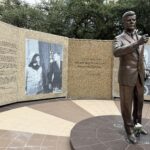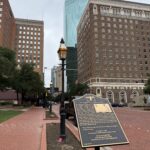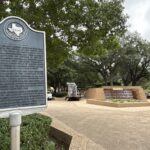Fort Worth, TX
35 miles west of Dallas, this Texas city has 918,915 (2020 census) people (Dallas–Fort Worth metroplex has 7 million).
We came here for Van Cliburn piano competition, which held at Bass Hall every four years.
Taking TRE train from Dallas, is about an hour, which is very convenient for us. However, the condition of the train, could have been better but I can handle it.
I prefer FT over Dallas. The Sundance Sq is pretty enchanting, so it the Water Gardens. Van Cliburn is everywhere in downtown area. Enjoyed the competition but the security at the Bass Hall is ridiculous.
When Medical Doctor William Davis and Dentist Osceola C. Queen arrived in Fort Worth during the late 1880s, they could only practice within the city’s Black business district (east of downtown). As their other colleagues came to Fort Worth, they too were confined to this one area of town. Even with these restrictions, excellent patient care was provided. George D. Flemmings served the community both as a dentist and as President of the local NAACP chapter. Three doctors established hospitals: Doctors Riley A. Ransom, George M. Munchus, and Eddie L. Dorsey. When Dr. Marion J. Brooks returned to town in 1951, he immediately became an outspoken medical activist for fair treatment that led to the integration of the city’s hospitals and other medical facilities. Today’s medical professionals stand on the shoulders of these dedicated community servants who confronted and overcame the obstacles in their lives with both compassion and grit.
Dr. Donald A. Brooks Dr. Marion J. Brooks PHOTO COURTESY OF THE SPOONS RASKILY
“We can all make our mark on the world. There is something to be said about knowing who you are.”
Dr. Kizzmekia S. Corbett
Viral Immunologist Scientific Leader on Coronavirus Vaccine
Sponsors: Texas Capital Bank Doctors Michael and Pavani Brooks Commissioner Roy C. and Dr. Jennifer Giddings Brooks
Heritage Trails 2021
A NOTORIOUS RED LIGHT DISTRICT KNOWN AS HELL’S HALF ACRE DEVELOPED IN THIS SECTION OF FORT WORTH AFTER THE ARRIVAL OF THE TEXAS AND PACIFIC RAILWAY IN 1876 LAUNCHED A LOCAL ECONOMIC BOOM. FORT WORTH WAS SOON THE FAVORITE DESTINATION FOR HUNDREDS OF COWBOYS, BUFFALO HUNTERS, RAILROAD WORKERS, AND FREIGHTERS EAGER TO WASH OFF THE TRAIL DUST AND ENJOY THEMSELVES. TO MEET THE DEMAND, A LARGE NUMBER OF SALOONS, DANCE HALLS, GAMBLING HOUSES, AND BORDELLOS OPENED BETWEEN THE COURTHOUSE SQUARE AND THE RAILROAD DEPOT.
ILLEGAL ACTIVITIES IN HELL’S HALF ACRE WERE TOLERATED BY CITY OFFICIALS BECAUSE OF THEIR IMPORTANCE TO THE TOWN’S ECONOMY. THE DISTRICT PROSPERED IN THE 18805 AND ADDED TO FORT WORTH’S GROWING REPUTATION AS A ROWDY FRONTIER TOWN. FAMOUS GAMBLERS LUKE SHORT, BAT MASTERSON AND WYATT EARP AND OUTLAWS SAM BASS, EUGENE BUNCH, BUTCH CASSIDY AND THE SUNDANCE KID ARE KNOWN TO HAVE SPENT TIME IN HELL’S HALF ACRE.
A 1906 NEWSPAPER HEADLINE CALLING THE DISTRICT FORT WORTH’S DEN OF SIN AND REFUGE OF CRIMINALS WAS REPRE- SENTATIVE OF PERIODIC EFFORTS TO CLEAN UP THE DISTRICT. THESE EFFORTS PROVED UNSUCCESSFUL UNTIL ARMY OFFICIALS AT CAMP BOWIE, ESTABLISHED HERE DURING WORLD WAR I. HELPED LOCAL OFFICIALS SHUT THE DISTRICT DOWN.
(1993)




